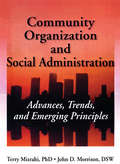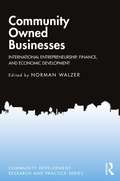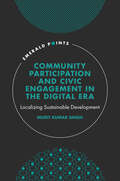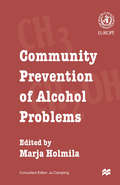- Table View
- List View
The Community of States: A Study in International Political Theory (Routledge Library Editions: International Relations #5)
by James MayallThis volume is a successor volume to The Reason of States. Part 1 discusses ways in which to understand the nature, possibility and limits of community beyond the state. Specific chapters are devoted to the practical attempts of statesmen, lawyers, strategists and economists to devise morally defensible international policies on the basis of interest. Part 3 challenges the conventional morality of states from alternative standpoints: Kantian morality, a reconsideration of the contemporary relevance of natural law, an examination of the concept of responsibility in international politics and an analysis of the role of language in the development of communities. .
Community Organization and Social Administration: Advances, Trends, and Emerging Principles
by Simon Slavin Terry Mizrahi, Phd John D MorrisonCommunity Organization and Social Administration presents a unique constellation of perspectives from scholars, researchers, and practitioners grounded in macro theories, practice, and education. Drawing upon the knowledge and experiences of social workers and other community-based professionals, this book provides a rich cross-section of models and strategies for those engaged in social change in the community, agency, and school or university. The chapters include data-based practice principles and guidelines for action.This book is a must for those who are teaching and practicing in community service, community change, and planning settings. Others who would benefit from the book include administrators of social service and community agencies; classroom teachers, field instructors, and students in organizing, planning, policy, and administration; policy analysts, program developers, and grant officers; and leaders and organizers of social change organizations, networks, and coalitions.Community Organization and Social Administration incorporates papers presented at the Symposia on Community Organization and Social Administration held at the Annual Program Meeting of the Council on Social Work Education. The papers are edited by members of the Association on Community Organizing and Social Administration (ACOSA).
Community Organization and Social Administration: Advances, Trends, and Emerging Principles
by Simon Slavin Terry Mizrahi, Phd John D MorrisonCommunity Organization and Social Administration presents a unique constellation of perspectives from scholars, researchers, and practitioners grounded in macro theories, practice, and education. Drawing upon the knowledge and experiences of social workers and other community-based professionals, this book provides a rich cross-section of models and strategies for those engaged in social change in the community, agency, and school or university. The chapters include data-based practice principles and guidelines for action.This book is a must for those who are teaching and practicing in community service, community change, and planning settings. Others who would benefit from the book include administrators of social service and community agencies; classroom teachers, field instructors, and students in organizing, planning, policy, and administration; policy analysts, program developers, and grant officers; and leaders and organizers of social change organizations, networks, and coalitions.Community Organization and Social Administration incorporates papers presented at the Symposia on Community Organization and Social Administration held at the Annual Program Meeting of the Council on Social Work Education. The papers are edited by members of the Association on Community Organizing and Social Administration (ACOSA).
Community Owned Businesses: International Entrepreneurship, Finance, and Economic Development (Community Development Research and Practice Series)
by Norman WalzerThis book analyses community-owned businesses in countries around the world to show successful approaches and important strategies to improve access to essential services in vastly different economic contexts. Through eleven chapters, authors from various countries use case studies and analyse findings in ways which can be applied to new development initiatives, including rural grocery store retention in Kansas, socially responsible community cooperatives in Italy, preserving pubs and shops in England and Wales, serving residents with special needs in Canada, and financing basic goods and services for aging populations in Taiwan, plus other examples. The chapters explore practices and approaches used in various locations to address concerns about loss of access to essential services, making clear that this approach to financing is useful in different scenarios. The chapters provide key insights suggesting that these approaches will be even more prevalent in the future and will be of interest to students, scholars, and community-development practitioners around the world.
Community Owned Businesses: International Entrepreneurship, Finance, and Economic Development (Community Development Research and Practice Series)
by Norman WalzerThis book analyses community-owned businesses in countries around the world to show successful approaches and important strategies to improve access to essential services in vastly different economic contexts. Through eleven chapters, authors from various countries use case studies and analyse findings in ways which can be applied to new development initiatives, including rural grocery store retention in Kansas, socially responsible community cooperatives in Italy, preserving pubs and shops in England and Wales, serving residents with special needs in Canada, and financing basic goods and services for aging populations in Taiwan, plus other examples. The chapters explore practices and approaches used in various locations to address concerns about loss of access to essential services, making clear that this approach to financing is useful in different scenarios. The chapters provide key insights suggesting that these approaches will be even more prevalent in the future and will be of interest to students, scholars, and community-development practitioners around the world.
Community Participation and Civic Engagement in the Digital Era: Localizing Sustainable Development (Emerald Points)
by Mudit Kumar SinghUnderstanding the challenges in research and practice of participation in the digital era, and the important role of local governance in achieving the sustainable development goals, Community Participation and Civic Engagement in the Digital Era unfolds the complex relationship of community participation, social capital and social networks. Singh presents an in-depth literature review alongside case studies from developing countries, showcasing the role of participation in sustainable development, and explaining how digital development creates technological tools and a virtual space for community engagement – increasing the complexity of community participation and civic engagement, and the potential for implementing the sustainable development goals at a local level. From the historic concept and forms of participation to describing and analysing the environmental and individual factors shaping practice of participation, community development interventions and local governance, the book culminates in a discussion of future work and challenges in the digital world. Delivering a careful review of the theoretical and practical problems of community participation in the digital age and featuring applied theories and cases which appeal to public policy makers and researchers, Community Participation and Civic Engagement in the Digital Era offers a rich theoretical perspective and detailed critical review of social capital and social networks that has profound application in the fields of political science, sociology and development economics.
Community Participation and Civic Engagement in the Digital Era: Localizing Sustainable Development (Emerald Points)
by Mudit Kumar SinghUnderstanding the challenges in research and practice of participation in the digital era, and the important role of local governance in achieving the sustainable development goals, Community Participation and Civic Engagement in the Digital Era unfolds the complex relationship of community participation, social capital and social networks. Singh presents an in-depth literature review alongside case studies from developing countries, showcasing the role of participation in sustainable development, and explaining how digital development creates technological tools and a virtual space for community engagement – increasing the complexity of community participation and civic engagement, and the potential for implementing the sustainable development goals at a local level. From the historic concept and forms of participation to describing and analysing the environmental and individual factors shaping practice of participation, community development interventions and local governance, the book culminates in a discussion of future work and challenges in the digital world. Delivering a careful review of the theoretical and practical problems of community participation in the digital age and featuring applied theories and cases which appeal to public policy makers and researchers, Community Participation and Civic Engagement in the Digital Era offers a rich theoretical perspective and detailed critical review of social capital and social networks that has profound application in the fields of political science, sociology and development economics.
Community Partnership Schools: Developing Innovative Practice Through University-Community Partnerships (Rethinking University-Community Policy Connections)
by Jarrad D. Plante Amy EllisThis book examines community partnership schools in the USA. Authored by academics and practitioners, it provides an overview of how community schools work in practice, provides a historical context of the model, and demonstrates the importance of the university-community connection in their effective running. Above all, the book showcases how community partnership schools are educational equity solutions that provide support services to underserved students, families, and communities. It will appeal to students and scholars of public administration, public policy, public health, and education, as well as practitioners.
The Community Planning Event Manual: How to use Collaborative Planning and Urban Design Events to Improve your Environment (Earthscan Tools for Community Planning)
by Nick Wates John ThompsonWant to improve your village? Your town? Your city? A community planning event may be just what you have been waiting for. All over the world people are organizing dynamic collaborative events to improve their surroundings. For a few intensive days, everyone concerned gets an opportunity to have their say and be involved - residents, businesses, professionals and politicians. It's effective and it's fun. From Nick Wates, author of the hugely successful Community Planning Handbook, comes this Event Manual, the first on the subject, which explains why and how to organize community planning events. The book is aimed at anyone - from concerned individuals to community groups to professional planners in business and government - interested in the remarkable potential of community planning events. It includes a step-by-step guide, detailed checklists and other tools for event organisers. The method is user-friendly, flexible and easy to employ in any context from small neighbourhood improvements to major infrastructure and construction projects anywhere in the world. With a Foreword by HRH The Prince of Wales and Introduction by John Thompson.
The Community Planning Event Manual: How to use Collaborative Planning and Urban Design Events to Improve your Environment (Earthscan Tools for Community Planning)
by Nick Wates John ThompsonWant to improve your village? Your town? Your city? A community planning event may be just what you have been waiting for. All over the world people are organizing dynamic collaborative events to improve their surroundings. For a few intensive days, everyone concerned gets an opportunity to have their say and be involved - residents, businesses, professionals and politicians. It's effective and it's fun. From Nick Wates, author of the hugely successful Community Planning Handbook, comes this Event Manual, the first on the subject, which explains why and how to organize community planning events. The book is aimed at anyone - from concerned individuals to community groups to professional planners in business and government - interested in the remarkable potential of community planning events. It includes a step-by-step guide, detailed checklists and other tools for event organisers. The method is user-friendly, flexible and easy to employ in any context from small neighbourhood improvements to major infrastructure and construction projects anywhere in the world. With a Foreword by HRH The Prince of Wales and Introduction by John Thompson.
The Community Planning Handbook: How People Can Shape Their Cities, Towns and Villages in Any Part of the World (Earthscan Tools for Community Planning)
by Nick WatesGrowing numbers of residents are getting involved with professionals in shaping their local environment, and there is now a powerful menu of tools available, from design workshops to electronic maps. The Community Planning Handbook is the essential starting point for all those involved: planners and local authorities, architects and other practitioners, community workers, students and local residents. It features an accessible how-to-do-it style, best practice information on effective methods, and international scope and relevance. Tips, checklists and sample documents help readers to get started quickly, learn from others' experience and to select the approach best suited to their situation. The glossary, bibliography and contact details provide quick access to further information and support. This fully updated new edition contains extra material on following up after community engagement activities.
The Community Planning Handbook: How People Can Shape Their Cities, Towns and Villages in Any Part of the World (Earthscan Tools for Community Planning)
by Nick WatesGrowing numbers of residents are getting involved with professionals in shaping their local environment, and there is now a powerful menu of tools available, from design workshops to electronic maps. The Community Planning Handbook is the essential starting point for all those involved: planners and local authorities, architects and other practitioners, community workers, students and local residents. It features an accessible how-to-do-it style, best practice information on effective methods, and international scope and relevance. Tips, checklists and sample documents help readers to get started quickly, learn from others' experience and to select the approach best suited to their situation. The glossary, bibliography and contact details provide quick access to further information and support. This fully updated new edition contains extra material on following up after community engagement activities.
Community Policing
by Mike Brogden Preeti NijharCommunity policing has been a buzzword in Anglo-American policing for the last two decades, somewhat vague in its definition but generally considered to be a good thing. In the UK the notion of community policing conveys a consensual policing style, offering an alternative to past public order and crimefighting styles. In the US community policing represents the dominant ideology of policing as reflected in a myriad of urban schemes and funding practices, the new orthodoxy in North American policing policy-making, strategies and tactic. But it has also become a massive export to non-western societies where it has been adopted in many countries, in the face of scant evidence of its appropriateness in very different contexts and surroundings. critical analysis of concept of community policing worldwide assesses evidence for its effectiveness, especially in the USA and UK highlights often inappropriate export of community policing models to failed and transitional societies.
Community Policing - A European Perspective: Strategies, Best Practices and Guidelines (Advanced Sciences and Technologies for Security Applications)
by P. Saskia Bayerl Ruža Karlović Babak Akhgar Garik MarkarianThis book provides a view into the multi-dimensional and multi-contextual nature of community policing. It brings together important conceptual discussions as well as numerous case studies and real-life examples of European community policing practices. It further offers insights into how the (primarily locally focused) concept of community policing fits into an increasingly interconnected world. Our book is intended for professionals working in community policing, academics and policymakers developing community policing procedures. In addition, the book aims to provide information for readers who are new to the subject of community policing. The wide range of examples and case studies make it also an excellent resource for teaching materials.
Community Power in a Postreform City: Politics in New York City
by Robert F. PecorellaThis book represents the culmination of several years of research on community politics in New York City.
Community Power in a Postreform City: Politics in New York City
by Robert F. PecorellaThis book represents the culmination of several years of research on community politics in New York City.
Community Power Succession: Atlanta's Policy Makers Revisited
by Floyd HunterHunter returns to Atlanta and reveals how the power structure of the 1950s has changed during the 1960s and 1970s. By combining scholarly analysis, personal reminiscences, observation, and social prescription, he provides a companion work that is as important as its predecessor. He compares the earlier circles of top leadership with the new men of power and examines substantive social change in power-structure relations, including the roles played by blacks and by white real-estate developers.Originally published 1980.A UNC Press Enduring Edition -- UNC Press Enduring Editions use the latest in digital technology to make available again books from our distinguished backlist that were previously out of print. These editions are published unaltered from the original, and are presented in affordable paperback formats, bringing readers both historical and cultural value.
Community Practice in the Network Society: Local Action / Global Interaction
by Peter Day Doug SchulerAround the world, citizens in local communities are utilising ICTs to underpin the creation of a participatory and democratic vision of the network society. Embedded in the richness and diversity of community practice, a vision of a 'civil network society' is emerging. A society where ICTs are harnessed as tools to improve the quality of life and reflect the diversity of social networks; where people are viewed as citizens, not just as consumers, and where heterogeneity is perceived as a strength rather than a weakness. Community Practice in the Network Society looks at the broad context in which this is happening, presents case studies of local projects from around the world, and discusses community ICT research methodologies. Not only does it highlight the symbiotic relationship between community ICT practice and research, but it also provides evidence supporting the case for the development of more inclusive and participatory pathways to the network society.
Community Practice in the Network Society: Local Action / Global Interaction
by Peter Day Doug SchulerAround the world, citizens in local communities are utilising ICTs to underpin the creation of a participatory and democratic vision of the network society. Embedded in the richness and diversity of community practice, a vision of a 'civil network society' is emerging. A society where ICTs are harnessed as tools to improve the quality of life and reflect the diversity of social networks; where people are viewed as citizens, not just as consumers, and where heterogeneity is perceived as a strength rather than a weakness. Community Practice in the Network Society looks at the broad context in which this is happening, presents case studies of local projects from around the world, and discusses community ICT research methodologies. Not only does it highlight the symbiotic relationship between community ICT practice and research, but it also provides evidence supporting the case for the development of more inclusive and participatory pathways to the network society.
Community Prevention of Alcohol Problems
by Marja HolmilaThis book is an action research study of a community at work. The community prevention project set the system in motion, revealing its character and internal dynamics. This process and its context are analyzed from a sociological point of view. It is shown that the type of community prevention that really works and creates sustainable changes, is neither value neutral nor given from above: it adheres to reason, rituals and emotions alike, and requires subjective involvement of the people in the community.
Community Prevention of Child Labor: Evidence-based Practices to Promote the Psychological Well-being of Minors (Human Well-Being Research and Policy Making)
by Isidro Maya JariegoThis book discusses preventive actions that have led to reduction in the prevalence of child labor across the world over the 21st century. It identifies exemplary programs in the area of community prevention that have had exceptional results; for example, the involvement of children in hazardous work globally being reduced by half. It documents a wide range of contexts where concerted action has counteracted social permissiveness towards child labor, including psycho-educational interventions in preventing early school leaving and conditional cash benefits which counteract family poverty. The book presents a set of evidence-based practices that are particularly useful for psychologists, educators, and social workers. More broadly, this book is also of interest to policymakers, professionals, and activists involved in child protection policy or in implementing programs to promote the psychological well-being of children.
Community Quality-of-Life Indicators: A Guide for Community Indicators Projects (Community Quality-of-Life and Well-Being)
by M. Joseph SirgyThis training book is designed to help professionals enhance their knowledge of community quality-of-life indicators, and to develop viable community projects. Chapter 1 describes the theoretical concepts that guide the formulation of community indicator projects. Chapter 2 creates a sample community indicator project as a template of the entire process. Chapter 3 describes the planning process: how to identify sponsors, secure funding, develop an organizational structure, select a quality-of-life model, select indicators, and so on. Chapter 4 focuses on data collection. Finally, Chapter 5 describes efforts related to dissemination and promotion of community indicators projects. Written by a stalwart in the field of quality-of-life research, this book provides the tools of sound community project planning for quality-of-life researchers, social workers, social marketers, community research organizations, and policy-makers.
Community Quality-of-Life Indicators: Best Cases III (Community Quality-of-Life Indicators #1)
by M. Joseph Sirgy Rhonda Phillips Don RahtzCommunity quality-of-life (QOL) indicators continue to gain attention and interest in their use as many communities and regions design and apply them. Evolving from early use as data systems, indicators are increasingly being integrated into overall planning and other public policy activities. Their use is found not only in monitoring and evaluation applications, but also in the context of increasing citizen partici- tion in guiding communities towards achieving desired goals. Indeed, the emphasis in many indicator applications now includes linking actions to outcomes – making sure that the indicators are integrated, useful and effective in helping communities address QOL issues. The use of QOL indicators to consider a full spectrum of c- munity and regional well-being is exciting and the focus on integration is certain to bring new and innovative applications to the forefront. This is the third book in a series covering best practices in community QOL indicators. Each volume presents individual cases (chapters) of communities at the local or regional levels that have designed and implemented community indicators programs. In Volume I, we present eight chapters from a variety of contexts – from the county level in the U. S. , to the large megalopolis of Sao Paulo, to looking at a cross section of communities throughout Europe. Also included are three chapters from Canada, a leader in applying community indicator systems.
Community Quality-of-Life Indicators: Best Cases IV (Community Quality-of-Life Indicators #2)
by Don Rahtz M. Joseph Sirgy Rhonda PhillipsCommunity indicators projects are plentiful. These projects capture the quality of life in towns, cities, counties, metropolitan regions, and larger geographic regions. Community quality-of-life (QOL) indicators are increasingly being integrated into overallplanningandotherpublicpolicyactivities.Thecommunityindicatorsproject reports are used not only in monitoring and evaluation applications but also in the context of increasing citizen participation in guiding communities towards achieving desired goals. This is the fourth book in a series covering best practices in community QOL indicators. Each volume presents individual cases (chapters) of communities at the local or regional levels that have designed and implemented community indi- tors programs. In Volume IV, we present nine chapters from a variety of contexts: cities such as the City of Phoenix (Arizona, USA), Jacksonville (Florida, USA), and Bristol (UK), suburban communities areas such as Long Island (New York, USA) and Sydney (Australia), larger regions such as Vancouver (Canada), and townships such as Sobantu (South Africa).
Community Quality-of-Life Indicators: Best Cases V (Community Quality-of-Life Indicators #3)
by M. Joseph Sirgy, Rhonda Phillips and D. RahtzThe proposed book is a sequel to volume 1-4 of Community Quality-of-Life Indicators: Best Cases. The first volume, Community Quality-of-Life Indicators: Best Cases was edited by M. Joseph Sirgy, Don Rahtz, and Dong-Jin Lee and published in 2004 by Kluwer Academic Publishers in the Social Indicators Research Book Series (volume 22). The second volume, Community Quality-of-Life Indicators: Best Cases II was edited by M. Joseph Sirgy, Don Rahtz, and David Swain and published in published in 2006 by Springer in the Social Indicators Research Book Series (volume 28). The third and fourth volumes, Community Quality-of-Life Indicators: Best Cases III and Community Quality-of-Life Indicators: Best Cases IV, were edited also by M. Joseph Sirgy, Rhonda Phillips, and Don Rahtz and published in 2009 by Springer in the ISQOLS Community Quality-of-Life Indicators Best Cases Book Series (volumes 1 and 2).

















